三重県桑名市の「六華苑」は、大正期の実業家、二代目諸戸(もろと)清六が建てた邸宅と庭園だ。住宅は重要文化財に指定されており、庭園と併せて一般公開されている。洋館と和館から成り、洋館部分は、教科書でも習う“お雇い外国人”の建築家、ジョサイア・コンドル(1852~1920年)が設計した。
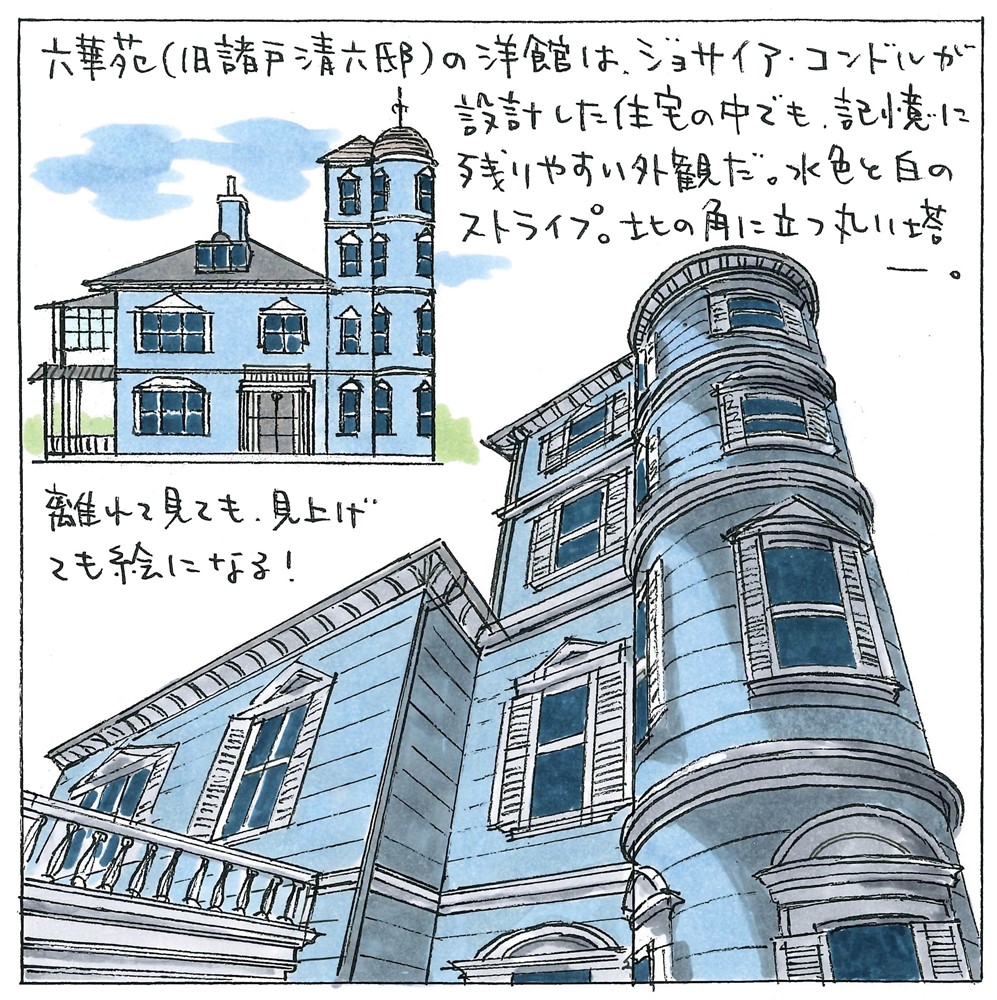
続きはこちら。
三重県桑名市の「六華苑」は、大正期の実業家、二代目諸戸(もろと)清六が建てた邸宅と庭園だ。住宅は重要文化財に指定されており、庭園と併せて一般公開されている。洋館と和館から成り、洋館部分は、教科書でも習う“お雇い外国人”の建築家、ジョサイア・コンドル(1852~1920年)が設計した。

続きはこちら。
Continuation from the previous article.

– When the competition results were announced, the construction was scheduled to be completed in 2021, but it has taken a long time for it to begin.
Daisuke Ibano(Associate Architect Global Design Group、Nikken Sekkei): Yes. Now, I (Ibano), Onishi and Nomura would like to explain what Nikken Sekkei has been doing in Barcelona since the competition results were announced.

– Yes, that is what I came here for today (laughs). In the timeline you just gave us, this is how it went after the competition, wasn’t it?
[From opening the Barcelona office until the start of construction]
May 27, 2016 Nikken Sekkei opens Barcelona office
May-July 2016 Design of the Presidential Box (VVIP Space)
Aug. 2016-July 2017 Preparation of city planning documents
Aug. 2017-Mar. 2018 Schematic Design phase
April 2018-May 2019 Change and addition to Schematic Design
May-Dec. 2019 Design Development phase
Jan. 2020-Dec. 2021 Change and addition to the Developed Design
Sept. 2022-Jan. 2023 Selection of contractor (Selected Limak from Turkey. Construction cost 960M Euros)
Mar. 2023-Aug. 2023 Design supervision for contractor’s proposal
Late June, 2023 Start of construction
– The competition winners were announced in March 2016, and you had already opened the Nikken Sekkei Barcelona office by May.
Ibano: The condition for entering the competition involved the competition winner setting up an office in Barcelona. We never thought we would win when we made the application, so we didn’t think much about it. After winning the competition, we rushed to open an office.
Teruyuki Nomura: I was the first to be assigned to Barcelona, followed by Ibano and Onishi. I had no idea that I would spend more than five years in Barcelona just designing.
Yoshito Onishi: I went to Barcelona with the intention of spending a few months there to put together the developed design, but ended up staying there for more than three years until the design development was completed.
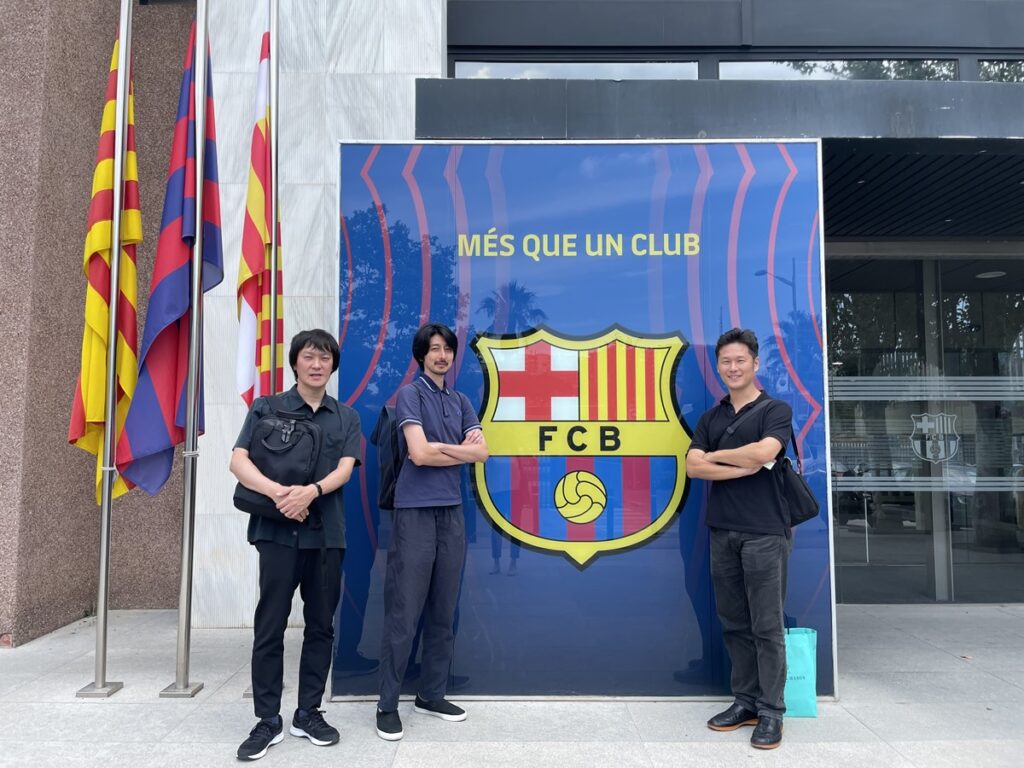
– That sounds straight out of a TV drama. How many people were in the Barcelona office?
Ibano: Including subconsultants, we had about 80 people working on the project at times.
– So many!
Onishi: The design of a large stadium requires many staff members because of the complexity of the functions and the large number of specialized consultants required. When we designed the Zaha Proposal for the New National Stadium, we had a total of over 100 people working on it.
– What kind of work did you start with?
Onishi: After winning the competition, we found that the application for city planning was not progressing as much as we had expected. If the existing stadium were to be enlarged with an addition, it would cover the road. So we had to move the road. Our first task was to prepare drawings to make changes to the city planning.
– Wow, you had to start there! The local collaborator was changed after the competition, right? It was Pascual Ausió Arquitectes at the time of the competition, but it is now a firm called b720.
Ibano: Yes, that’s right, the first year we were busy with the administrative procedures I just mentioned, and in the second year, when we were finally about to sign the schematic design contract, they dropped out of the project.
Onishi: Nikken Sekkei basically doesn’t do architect of record (AoR) work overseas, so we looked for an alternative local office that could do the AoR based on its achievements. We asked b720, a relatively large design firm in Barcelona with an extensive track record of collaboration with overseas firms, to join our team. The Torres Porta Fira (2010), built by Toyo Ito in Barcelona, was also realized in collaboration with b720.
Nomura: Personally, the first three months or so of the schematic design phase were the hardest. Pascual Ausió Arquitectes, who had been working with us until then, left, and we had to make the b720 members understand the project from scratch. The schematic design period was set at 8 months, and since there was no locally hired staff at that time, most of the work was done in collaboration with our Japanese members stationed in Barcelona and those working in Japan.
– Please excuse my bluntness, but why did it take so long to start construction? If you look at the timeline I mentioned earlier, there are 14 months of “modifications to the schematic design” after the schematic design (8 months) and 24 months of “modifications made to the developed design” after the design development (6.5 months)…
Onishi: With so many stakeholders, demands change quite often. If we make a proposal according to a changed requirement and are told that the budget does not fit, we have to start over and make another proposal.
Ibano: It was like trying to wring out a dry towel.
– I see. Five years of that sounds excruciating. I had been thinking you were having so much fun in Barcelona. So sorry.
Ibano: I mean, there were a lot of fun things too, but it definitely gave us thick skin.
– Was there a reason you were finally able to start construction?
Ibano: The construction conditions were reviewed when Joan Laporta became the new president of FC Barcelona in March 2021.
At the time of the competition, it was postulated that the renovation work would be done in stages during the off-season only, but the Club decided to close Spotify Camp Nou for construction this season (2023) until the middle of next season (2024). During this period, the Olympic Stadium in Montjuïc will be the home ground of FC Barcelona.
– Have there been any big changes from the competition stage?
Ibano: The exterior and concept have not changed significantly. The major change in planning was that while the competition plan called for dismantling the existing firsttier and building an addition on the first tier and outside, the development plan called for dismantling the third tier and building a new one.
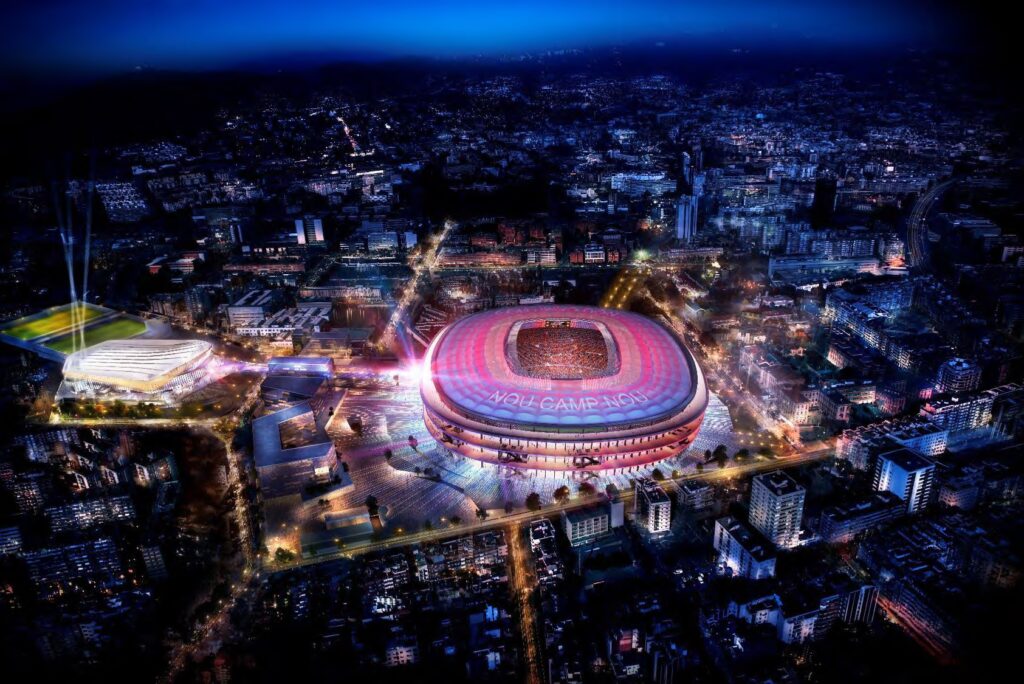
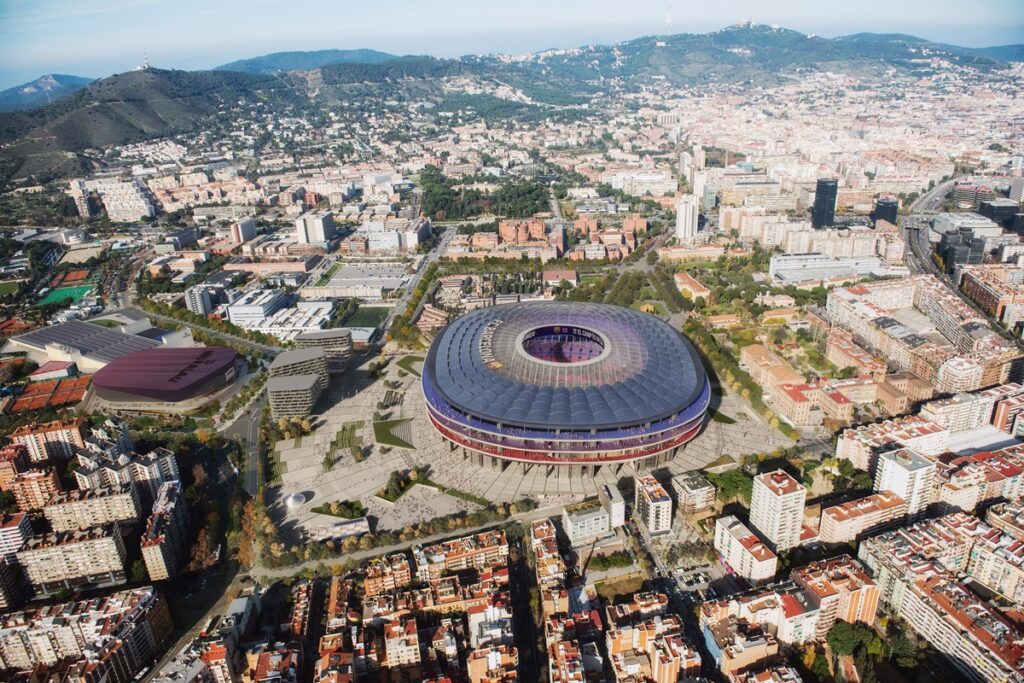

– So it was the third tier that was getting torn down at the site.
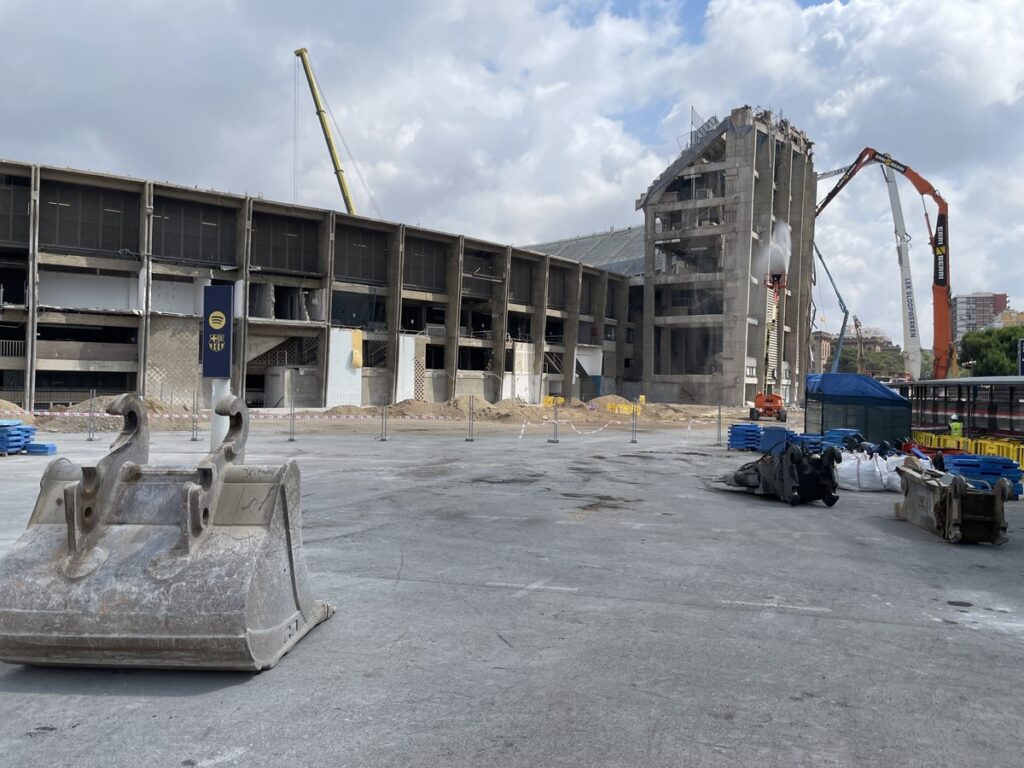
Onishi: The original stadium designed by Francesc Mitjans in 1957 was a magnificent design, and we are trying to make the most of it. The third tier, which is now being demolished, was added later, and the extension was not particularly well-thought-out in its design, so we will rebuild the third tier and put the VIP seating between the second and third tiers.
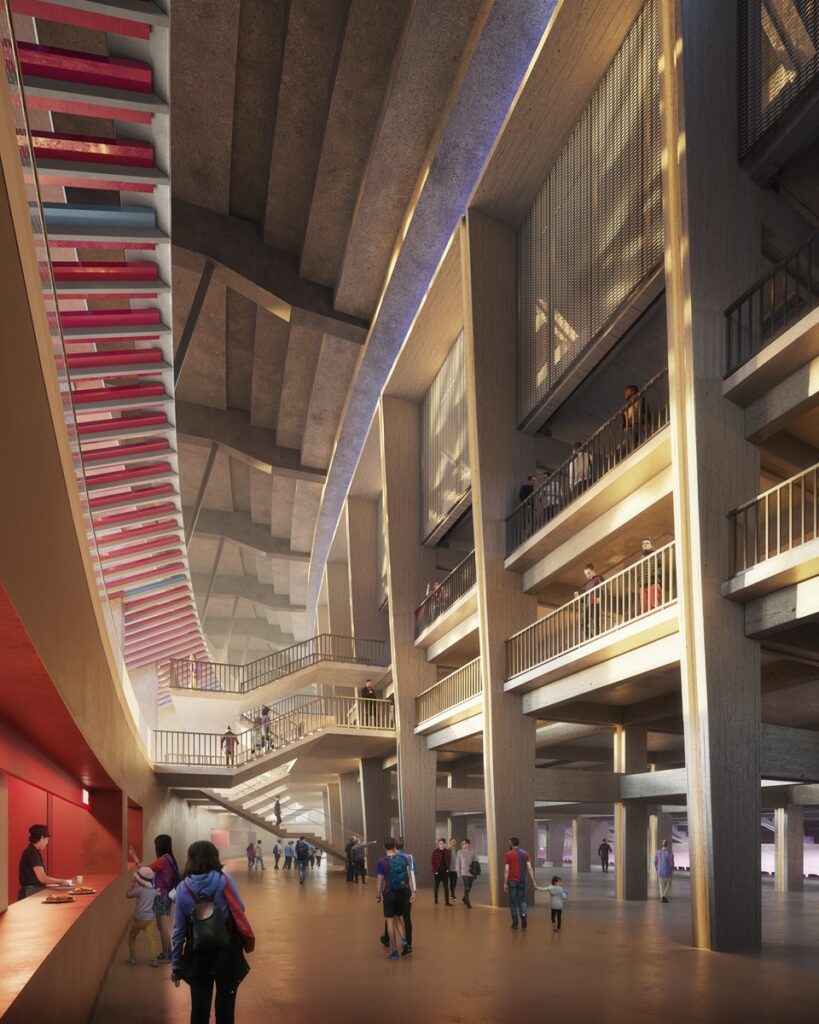

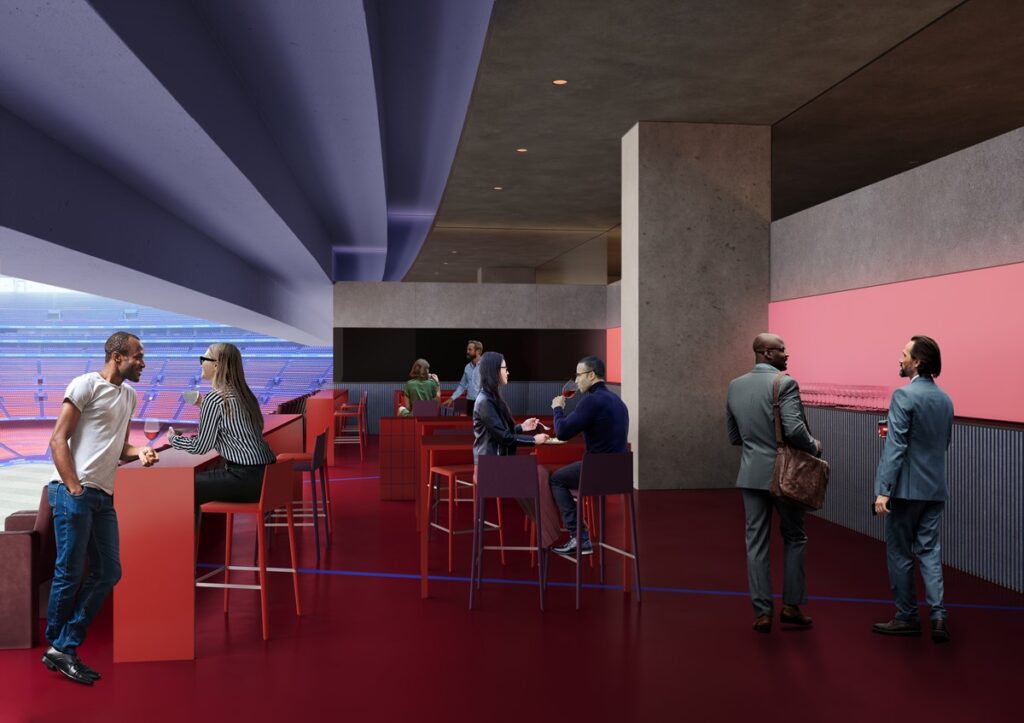

Nomura: The first and second tiers are also difficult to move because many of the long-time Socios have seating rights.
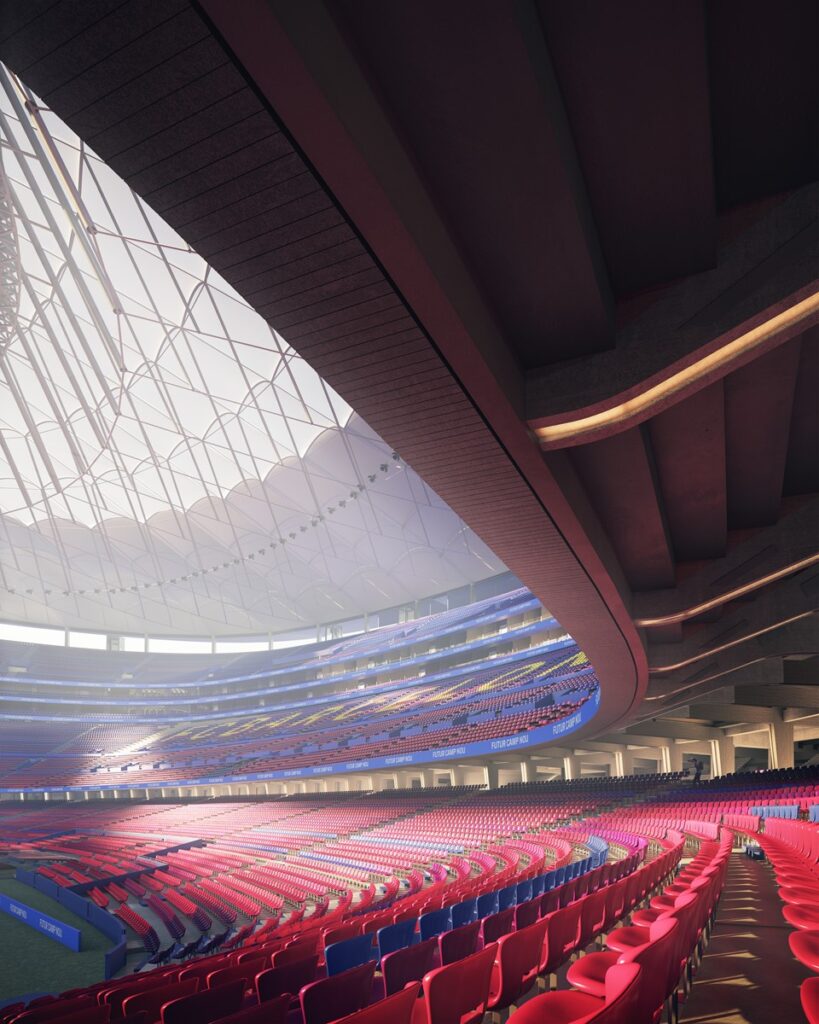

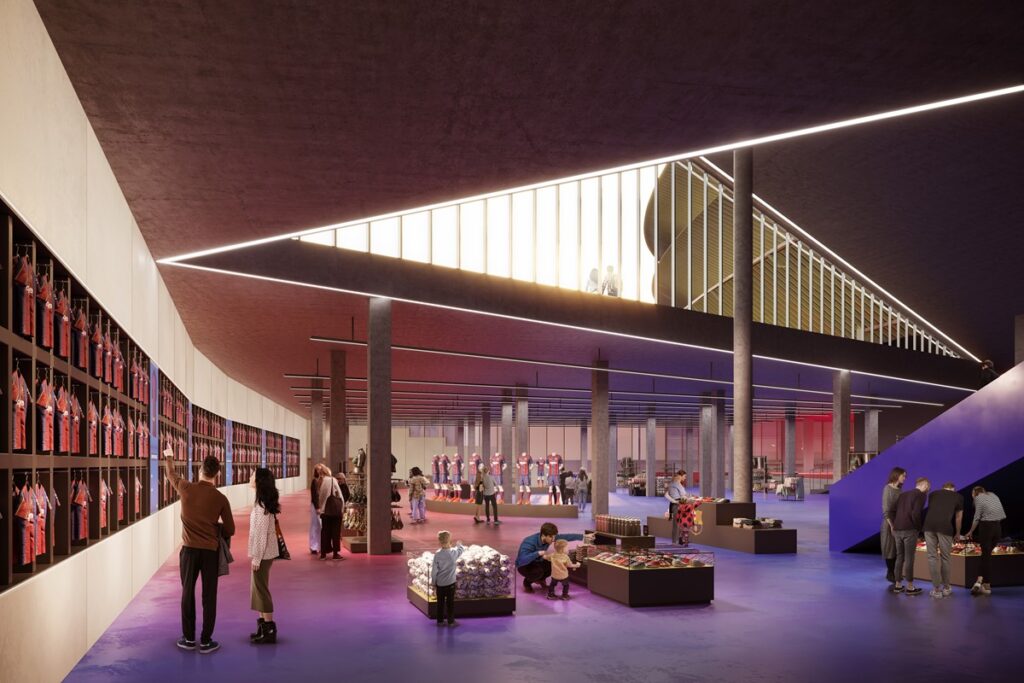
– Where does Nikken stand now?
Ibano: In February 2022, we completed the design development work and returned to Japan; the AoR was changed from IDOM+b720 to Torella+JG. In January 2023, the contractor was decided, Limak of Turkey, and we are currently performing as Design Guardian of the Spotify Camp Nou project.
Continuation from the previous article.
– What was the starting point in putting together the proposal?
Tadahiko Murao (Executive Officer, Principal, Global Design Group,Nikken Sekkei): Among the important keywords in the workshops provided by the FC Barcelona officials, the one that stuck with us the most was the word “democratic.” They told us that FC Barcelona is operated by “Socios,” which is what makes it democratic. Because I had never been asked for “democratic architecture” in Japan up until now, I was very moved.
– You certainly don’t hear that often in Japanese architecture today.
Murao: They are serious about it. Even though there is a roof only over the top of the main stand at this moment, rich, not-so-rich, tourists, and locals, people cheer all together for FC Barcelona on the pitch once they come to this stadium. They wanted to create a stadium where people could feel that sense of unity. What was important to them was the roof—the roof is a symbol of democracy that creates a sense of unity.
Considering what they said, we decided to make a roof that covers the same cross-section wherever the cross-section is. People will be under the same roof wherever they look up from. That would be democracy.
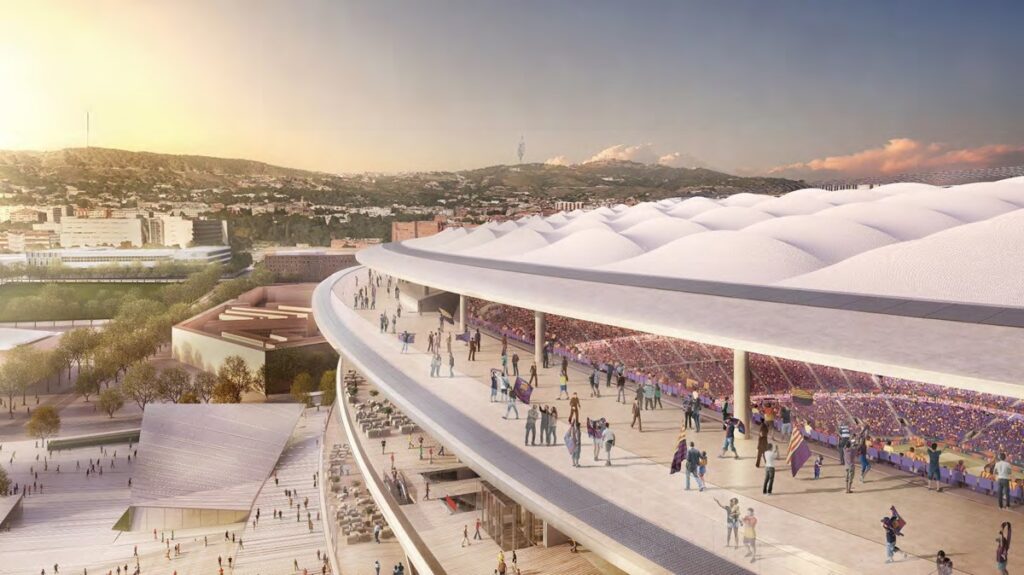

– How about the concourse that features its exterior?
Murao: In the competition guidelines, the conceptual drawing showed a cross-section of the stadium with a soft facade on the outermost part of the stadium. We felt uncomfortable with that. Despite our discomfort, we all drew various sketches of the facade.

But none of them felt right. As we worked on the project, we began to talk about whether the facade is really necessary. Since Barcelona faces the Mediterranean Sea, it is quite warm even in winter. Therefore, it would be a waste to spend money on the facade. We suggested adding a 20-meter-wide balcony on three stories, extending outward from the columns of the existing structure, instead of spending money on the facade. An open balcony would not only help the flow of people during games but also serve as a place for people to meet and relax. It also contributes to a business if concessions are placed here. We proposed that three levels of open and pleasant balconies would make the entire stadium function as a park or a public space. The balconies themselves with 100,000 visible spectators become the facade of the stadium.
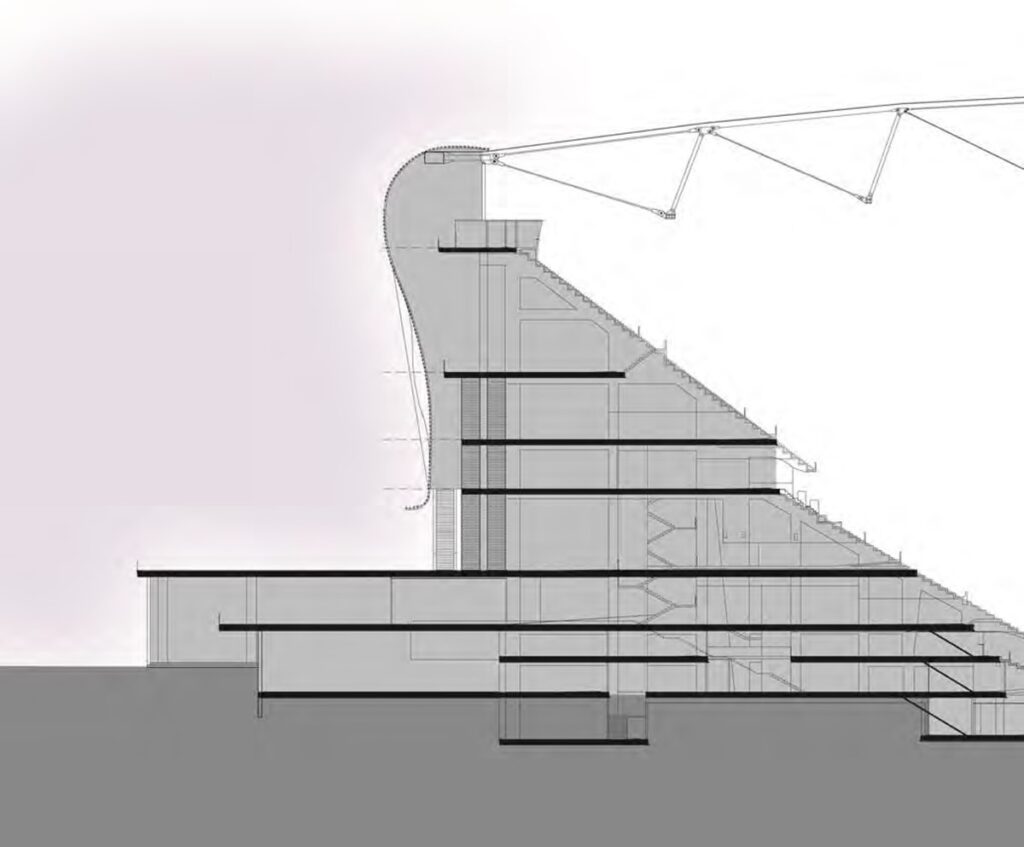

–So the proposal is different from the image in the brief?
Yes. There was another key proposal as a set with the exterior, which was also different from the requirements. It is a series of 12 cores. The stairs, elevators, escalators, and equipment shafts are all in one core. We thought it would be a good idea to build these in the first phase of construction.
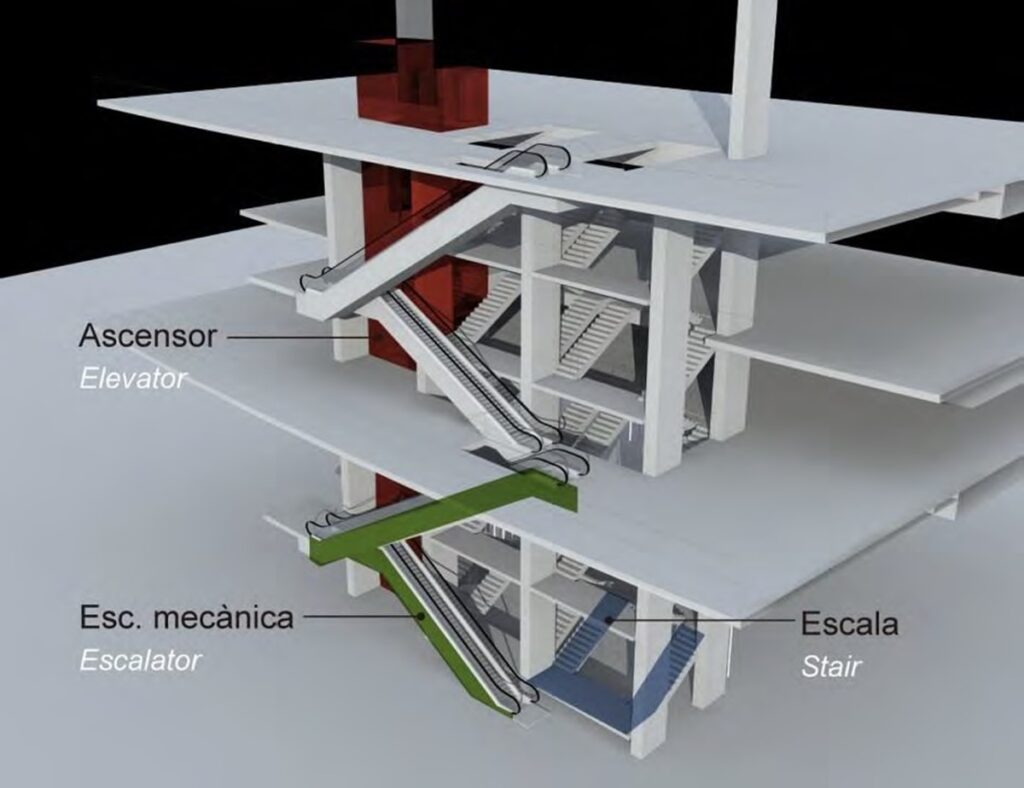
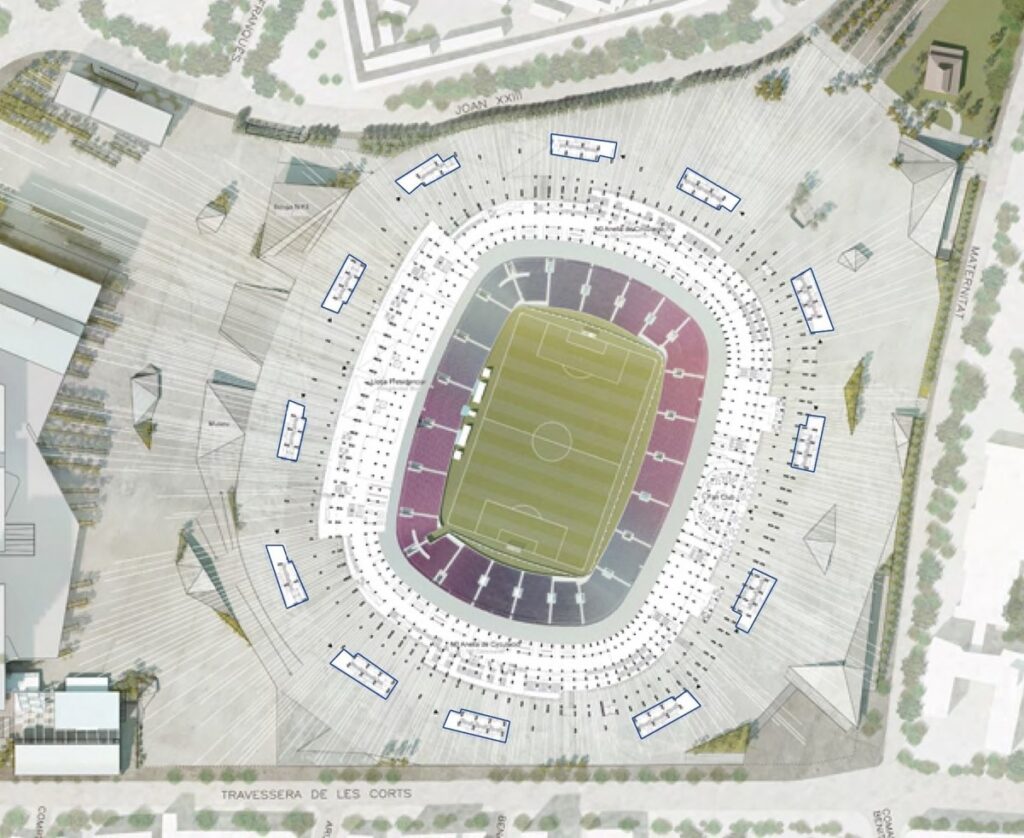
The competition guidelines included a picture of a pedestrian deck, called an amoeba, that circles the second-floor level of the stadium perimeter. The idea was to bring people up to the second floor and then move them around. However, when we ran a simulation, we found that a spacious balcony and the 12 cores would create less congestion for people to move through. This would be less expensive than building a large deck as well.


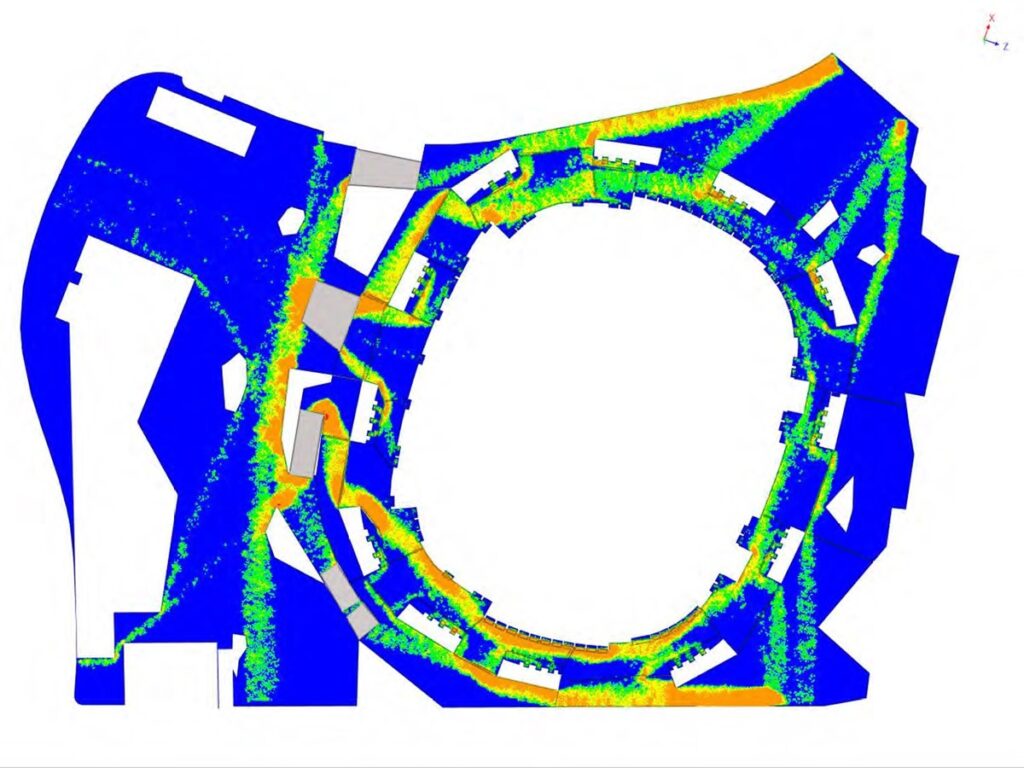
– This simulation was performed by Nikken Sekkei in-house?
Murao: No. We had the simulation done by a company called Momentum in the UK. Even though we could do the simulation in-house, we thought it would be more credible than having Nikken Sekkei do it ourselves. It was a shock to them as well. FC Barcelona had to ask us, “Are you sure about that?”
By the way, as to why we decided on 12 cores, we were thinking of 6 or 8 at first. But then, we thought that “football is played by 11 people, and we should add the supporters to make it 12.” Because all the members of the design team said it was a good number, we tried on 12. As a result, the flow of the people improved very much.
By building the 12 cores in the first phase of construction, the vertical circulation of the stadium can be established. It solves the difficult issue of seating 80,000 people during the construction. In addition, the diagonally cut balcony shape, which inherits the memory of the existing roof shape, allows light to enter the concourse, as well as the wind to flow. The wind flow will also have a positive effect on the growth of the turf on the pitch. The open balcony solves several difficult issues while further making it a fun place to be.
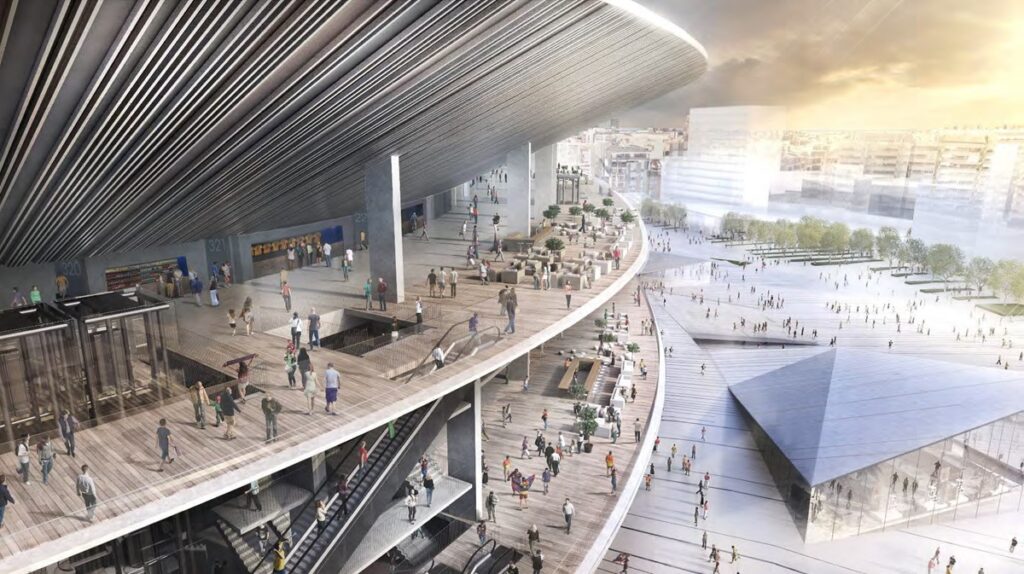
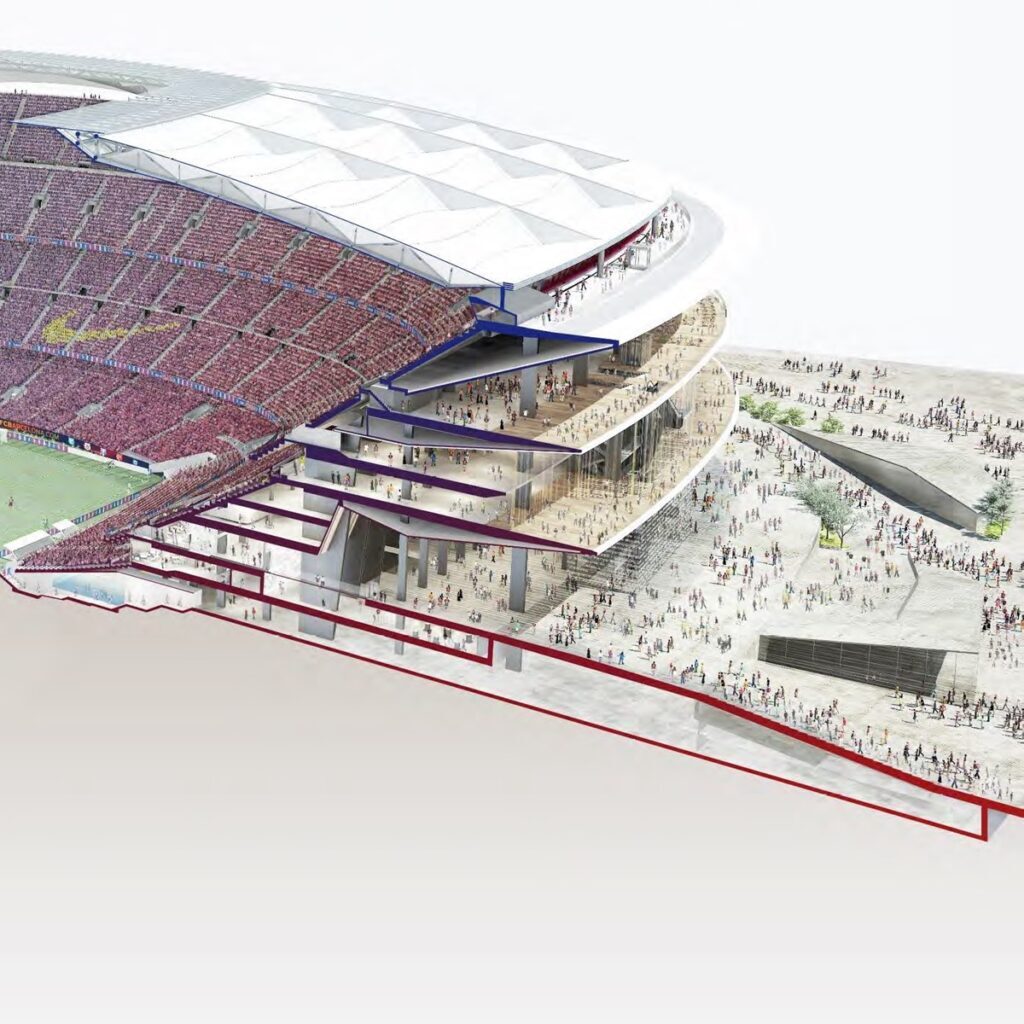
– So you were selected with this unique proposal (the result was announced on March 8, 2016).
Murao: Yes. It is something we were able to propose, because of our position that we had nothing to lose.
To be continued (design development).
–Many people read the article we wrote in Barcelona, about the beginning of construction on Spotify Camp Nou (https://bunganet.tokyo/barcelona1/). Thank you all for taking time out of your busy schedules in Barcelona.
All: Thank you as well.

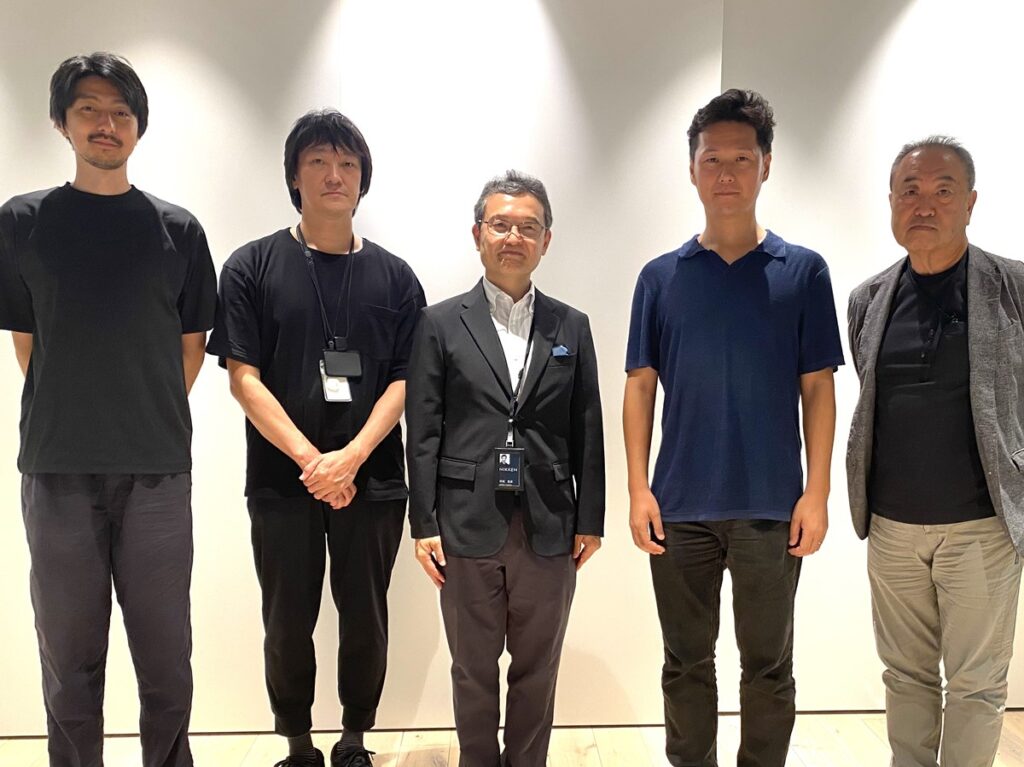
Tadahiko Murao (Executive Officer, Principal, Global Design Group): Since you have featured Spotify Camp Nou in the book you published, “Unknown Nikken Sekkei,” I am sure that you know most about the project. Hence, I will first talk about the raw and uncut stories during the competition. Then Mr. Ibano will talk about the subsequent stories.
– Wow, we’re excited to hear about the competition!


Murao: First, let me give you the chronology of events.
[From competition announcement to winning]
June 5, 2015 The international design competition to renovate the Camp Nou announced (360M Euro construction budget)
July 6, 2015 Credential review and built projects submission (26 teams applied from all over the world)
July 17, 2015 PM Abe announces the rejection of Zaha’s National Stadium design
Sept. 1, 2015 New National Stadium development competition announced
Sept. 7, 2015 Nikken Sekkei announces a plan to enter the competition as a team with Zaha Hadid Architects
Sept. 8, 2015 8 finalists announced for the Camp Nou international competition
Sept. 18, 2015 Nikken Sekkei and Zaha Hadid Architects do not form a joint venture with a construction company. The National Stadium competition is abandoned.
March 8, 2016 Nikken Sekkei wins the Camp Nou competition
[From opening the Barcelona office until the start of construction]
May 27, 2016 Nikken Sekkei opens Barcelona office
May-July 2016 Design of the Presidential Box (VVIP Space)
Aug. 2016-July 2017 Preparation of city planning documents
Aug. 2017-Mar. 2018 Schematic Design phase
April 2018?May 2019 Change and addition to Schematic Design
May-Dec. 2019 Design Development phase
Jan. 2020-Dec. 2021 Change and addition to the Developed Design
Sept. 2022?Jan. 2023 Selection of contractor (Selected Limak from Turkey. Construction cost 960M Euros)
Mar. 2023-Aug. 2023 Design supervision for contractor’s proposal
Late June, 2023 Start of construction
– Wow, this alone made it worth coming here today. This will be useful for the book I have wanted to write someday! So, the start was in June 2015? Was this an open competition?
Murao: Yes. Spotify Camp Nou was built in 1957 and designed by an architect named Francesc Mitjans. There have been two major additions to the building until now. There have been problems such as insufficient spacing between seats and aisles, the roof of the seating area being only on the main stand side, and few VIP areas. In addition, there is underground parking around the facility, but the parking ramp is in the middle of the plaza, so during the games, the circulation of cars and people intersect.
The competition was a two-phase system. The first phase was a review of qualifications, including past performance, team structure, and concept. The second phase was to present a concrete proposal. The requirements were as follows.
[Competition structure]
Two-phase selection
Phase 1: Credentials review (Past work, team structure, concept, etc.)
Phase 2: Concrete proposal
[Brief requirements]
■Number of seats: 99,354 (32,000 for 1st level, 39,000 for 2nd, 28,000 for 3rd)
⇒Expanded to 105,000 seats (20,000 for 1st level, 38,000 for 2nd, 47,000 for 3rd)
■Installation of a roof covering all seats
■Proposal for a new facade including vertical circulation (additional elevators and escalators)
■Complete renewal of the space for spectators (VIP room, lounge, etc.)
■Expansion of the museum and mega store
■More than 80,000 seats will remain available during the renovation period (85,000 of 142,000 Socio members have their own seats)
■Construction period: 2017-2021 (given at time of competition)
[Judges]
■FCB: Josep Maria Bartomeu, Susana Monje, Jordi Moix, Emili Rousand
■Architect: Juan Pablo Mitjans (son of the current Camp Nou architect)
■Lluis Cameron, Arcadi Pla, and Joan Forgas, Architectural Institute of Catalonia
■Aurora Lopez, City of Barcelona (Urban Planning Department)
■William Thomas Mannarelli, FCB Technical Team Leader
The most difficult requirement at that time was to secure more than 80,000 seats during the renovation construction. FC Barcelona has been operated by the fans called “Socios.” There were about 140,000 Socios at that time, and about 80,000 of them had their own seats at Spotify Camp Nou. So, it is difficult to say that “The team will play in another stadium during construction.”
– I’m a little hesitant to ask this, but does that mean you decided to apply while the design development for Zaha’s new National Stadium was ongoing? It was July 17, 2015, when the design was withdrawn.
Murao: Yes, we decided before the withdrawal. The requirement was to work with a local architect office, and we teamed up with Pascual Ausió Arquitectes in Barcelona. There was a Spanish employee at Nikken Sekkei who told me that Pascal’s office wanted to enter the competition in partnership with Nikken Sekkei. At the time, I was working on the design development of Zaha’s scheme for the new National Stadium. Like I said, I just thought we would tentatively try entering the first phase.
– So, it was not like another shot at the new National Stadium?
Murao: We submitted the first-phase application materials on July 6. When we were told on September 8 that we had been selected as finalists, there was a bit of an uproar within the company.
[The 8 teams in the second phase]
NIKKEN SEKKEI + Joan Pascual i Ramon Ausió Arquitectes
AECOM + b720 Arquitectes
AFL + Mateo Arquitectura
Arup Sport + Taller d’Arquitectura Ricardo Bofill
BIG + IDOM + BAAS Arquitectes
GENSLER Sport + OAB
HKS + COX + Batlle i Roig Arquitectes
POPULOUS + Mias Arquitectes + RCR Arquitectes
– In Japan, September 8 was…
Murao: It was around the time when we were talking about teaming up again with Zaha office to participate in the redo proposal for the new National Stadium. We were talking about what we would do if both proposals passed (*Nikken Sekkei ultimately declined to participate in the redo proposal). Even though we thought that we could work on both, we believed that there was no way we could win the Camp Nou. After all, it was these eight teams who had been selected.
– Ricardo Bofill and BIG remained.
Murao: Although I wrote Nikken Sekkei at the top of the list, I think we actually started at the bottom. But I think that worked well. When Nikken Sekkei enters a competition in Japan, we cannot ask strange questions and submit unconventional proposals. We are always required to submit a proposal that complies with requirements. But since we were probably the last on the list for this one, we considered what we could do instead.
– Is the second phase a one-shot proposal?
Murao: They told us they were going to do it in a workshop format. They said, “This is the Champions League.” We had meetings and worked out the schemes in stages, and we were narrowed down to four teams, then to two, then to one. That is how they would decide.
– How did you climb up from the bottom of the pack?
Murao: I don’t think people were expecting much from us at first. Since the team that worked on the new National Stadium took the lead, we were able to answer any questions that were asked during the workshop. The Zaha’s proposal for the new National Stadium dealt with the most difficult constraints in the world, and we had to consider all the various conditions. This meant that we were prepared to answer all the questions they asked flawlessly. How the roof should be, how the wind should flow onto the pitch, and so on. As we talked during the workshops, they started to think, “These people really know their stuff.”
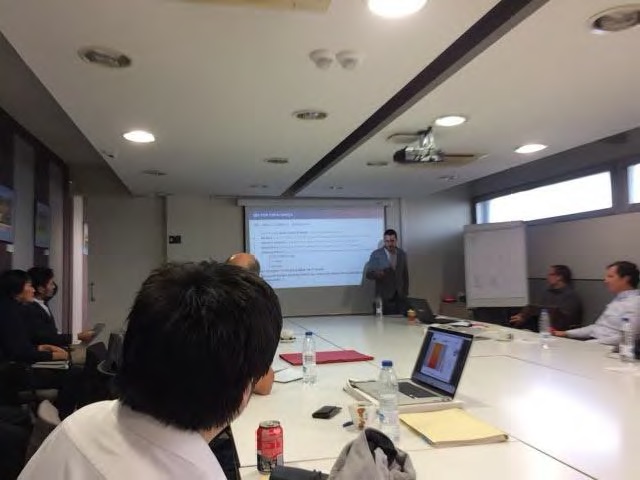
– Did the members of the new National Stadium all join the Spotify Camp Nou project?
Murao: Ibano volunteered himself when there was an internal call for members. This was the team. It must be unprecedented to have so many members lined up. We put particular emphasis on the presentation. We tried to convey the message with graphics and drawings rather than words.

To be continued (the final round).
秘話②から続く。(聞き手:宮沢洋)

──コンペ結果の発表時には「2021年竣工」と聞いていましたが、着工までだいぶ時間がかかりましたね。
伊庭野大輔:はい。ここからは、コンペ以降に日建設計がバルセロナでどんなことをやっていたのかを、私(伊庭野)と大西、野村からご説明したいと思います。
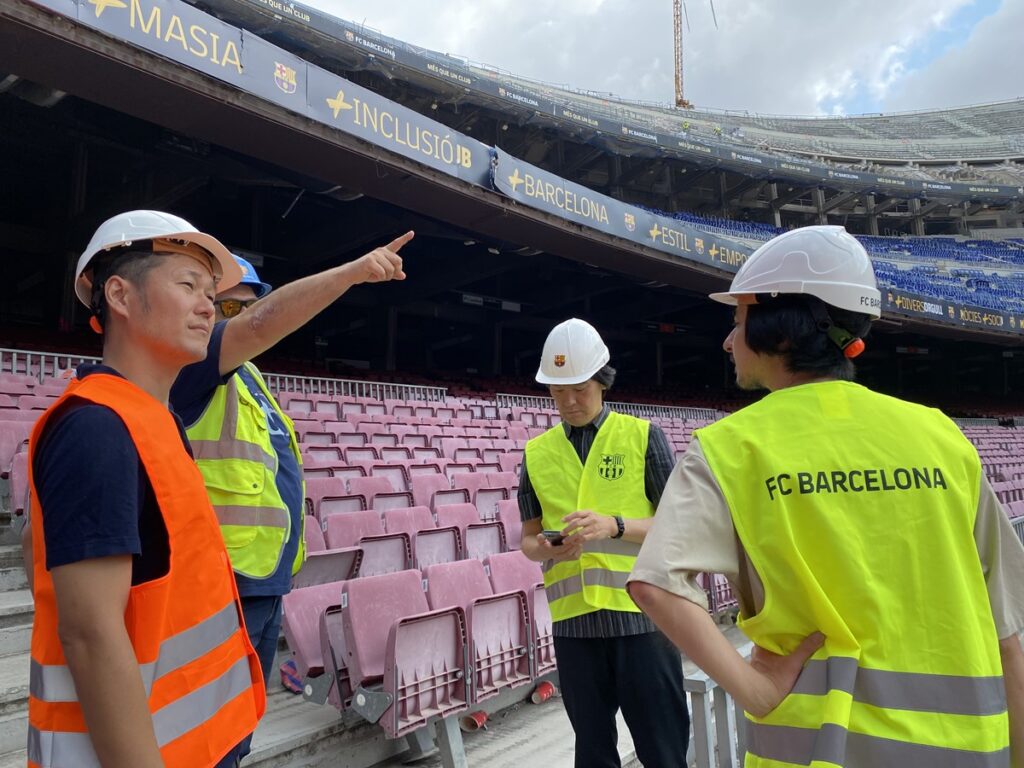
秘話①から続く。(聞き手は宮沢洋)
──提案をまとめていくうえで、何がとっかかりになったのですか。
村尾忠彦(日建設計執行役員 グローバルデザイングループ プリンシパル):ワークショップの中でFCバルセロナの関係者から重要なキーワードがいろいろありましたが、一番刺さったのは「デモクラティック(民主的)」という言葉でした。FCバルセロナは「ソシオ」が運営している。だから「デモクラティック」なんだと。今まで日本で設計をしていて、「民主的な建築に」と言われたことはないので、感動しました。
──確かに、今の日本の建築ではあまり聞きませんね。
村尾:彼らは真剣に言うんですよ。今はメインスタンドの上のところだけに屋根があるけれど、このスタジアムに来たら、お金持ちもそうでない人も、観光で来た人も地元の人たちも皆が一緒になってピッチの中でFCバルセロナを応援する。そういう一体感の感じられるスタジアムをつくりたいんだと。そこで重要なのが屋根で、屋根は一体感をつくりだす民主主義の象徴なんだと。
そんなふうに言われてどうしようかと考えたんですけれども、ならば屋根はどこの断面をとっても同じ断面の屋根がかぶさるようにしようと。どの席から見上げても、一つの同じ屋根。それが民主主義だろうと。

スペイン・バルセロナで進む「Spotifyカンプ・ノウ」(FCバルセロナの拠点)の再生計画について、日建設計の設計チームに独占取材した。その内容を3回に分けてお伝えする。(聞き手は宮沢洋)
──バルセロナで書いた「Spotifyカンプ・ノウ」着工の記事がすごく読まれました。現地ではお忙しいなか、ありがとうございました。
全員:こちらこそありがとうございました。

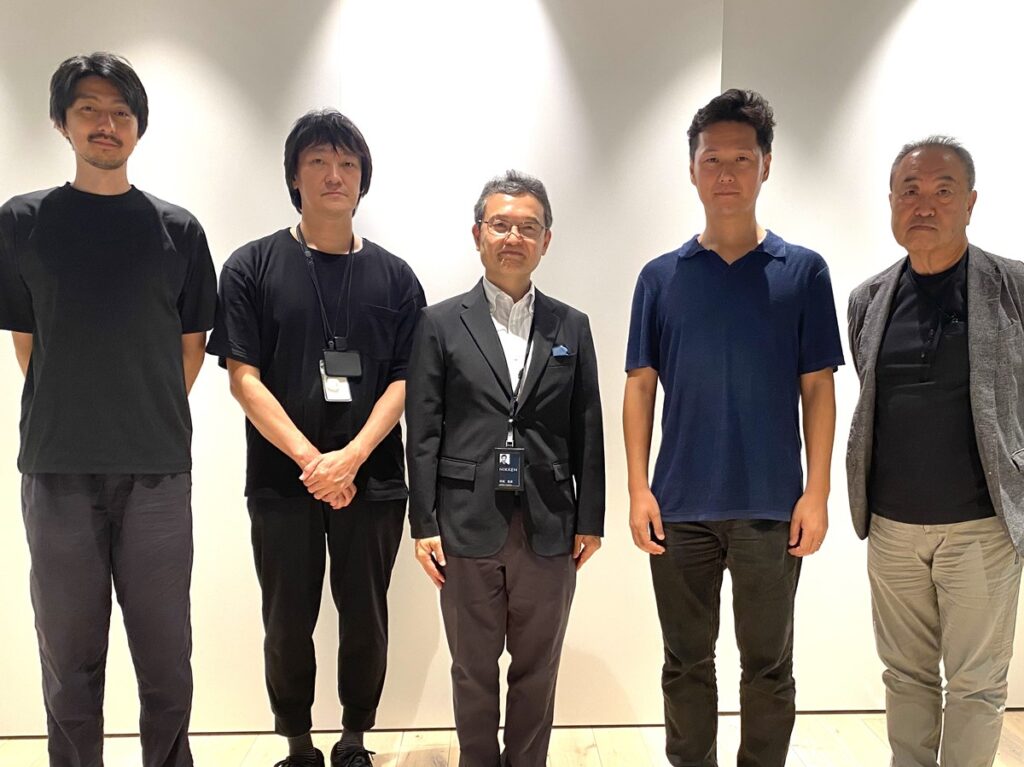
速報時にあやふやな書き方をしていた3か所に、森ビルから補足説明が届いたので、加筆した。青太字は森ビルの補足説明、黒太字はそれに対する宮沢の追記。特に、「T-デッキ」についての補足は専門家には貴重な情報だ。(ここまで2023年10月19日に加筆、以下は2023年10月2日の速報)
「巨大建築に抗議する」という論考を、建築評論家の神代雄一郎(こうじろゆういちろう、1922~2000年)が『新建築』誌上で発表したのは1974年9月。それからしばらく“巨大建築論争”と呼ばれる意見の応酬が続いた。来年(2024年)は「巨大建築論争50周年」となる。どこかの媒体からそういう原稿依頼があったらすぐに書けるように、最新の超高層ビルを見てきた。10月6日(金)に開業する「虎ノ門ヒルズ ステーションタワー」である。
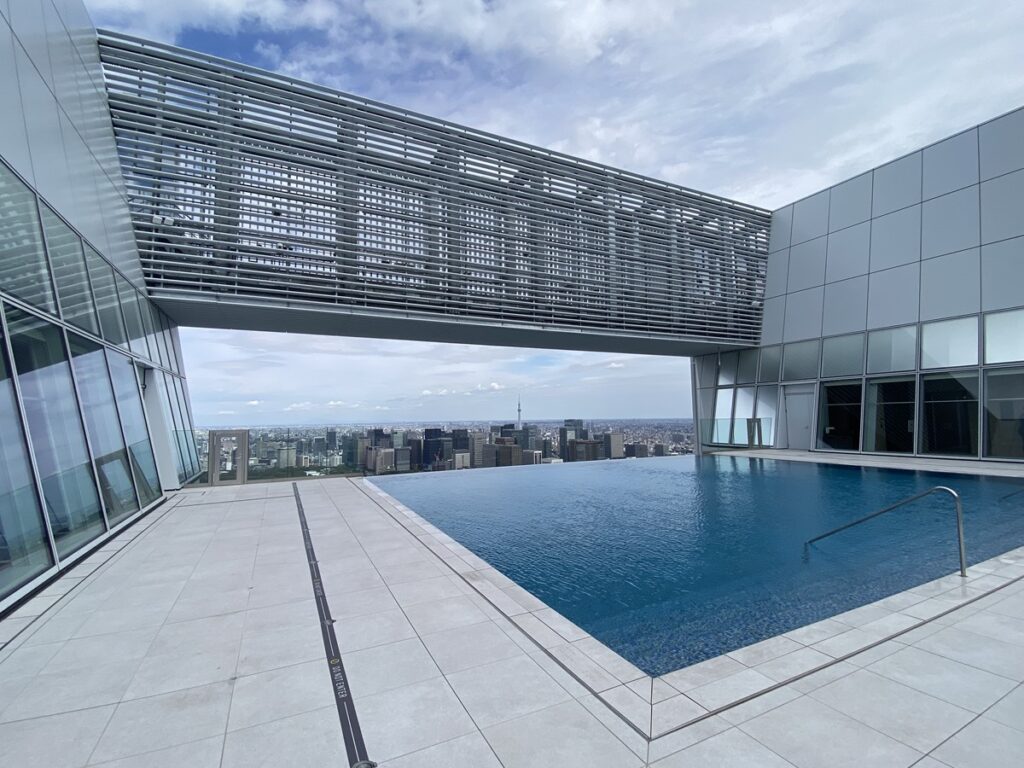
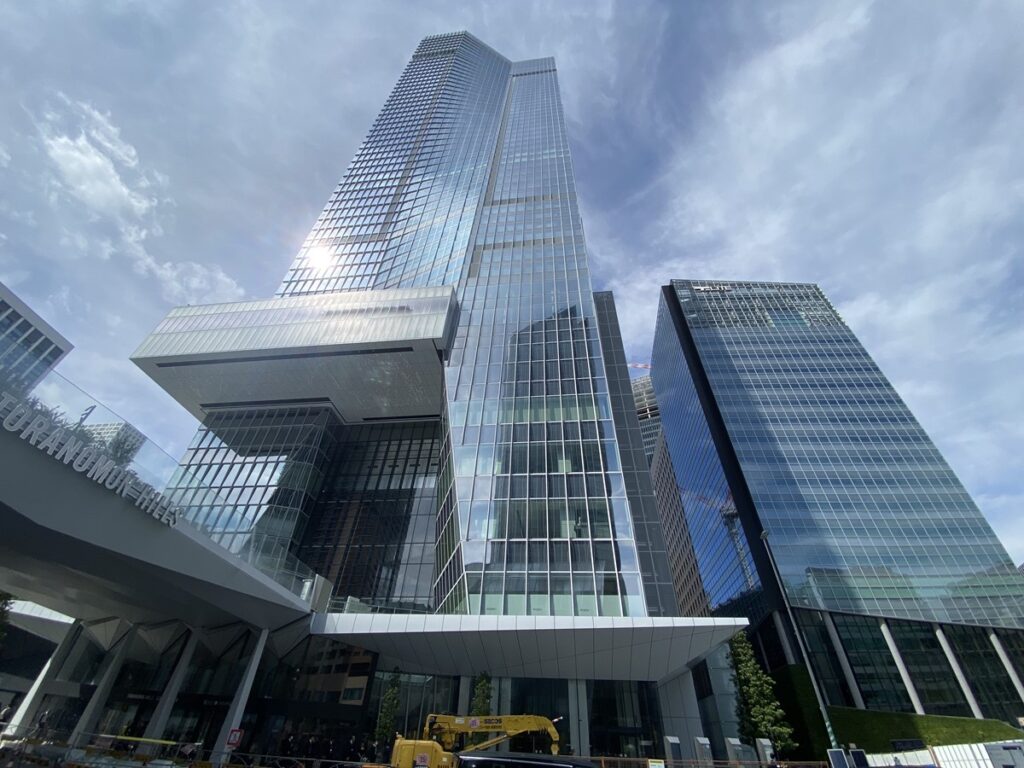
建築のデザインに関わる僕らにとって「かたち」は重要である。
ある大手デベロッパーのトップは「予算が潤沢にあるときは『かたち』で、そこそこあるなら『素材』で、そして足りないときには『色』で勝負だ!」とおっしゃっていた。賃貸オフィスという典型的な収益ビルのビジネスの世界で長年にわたりプレゼンスを示されてきた方らしい、簡潔ながら的確に建築デザインの勘所を捉えた言葉であると同時に、建築における「かたち」の重要性を言い当てているように感じた。
だが残念なことに、こうした「かたち」を重んじた言葉を聞く機会は、実務の場においては極めて稀だ。「デザイナーとして誰を使うか」については熱心に議論されても、デザインそのものについての議論は、ほとんどなされない。もしくは逆に、個人の趣味をベースにした迷走による設計変更をいたずらに繰り返しているケースが多い。機能は議論されるが、デザインや「かたち」に関わることは議論されないという不思議な風潮が日本の建設ビジネス界には色濃く存在する。いやむしろ「かたち」にこだわる議論は悪しきものと捉えられているようだ。
たとえば、「かたちから入る」という言葉がある。より俗語的な「格好から入る」という言葉もほぼ同義だと思うが、実務の場では「『かたち』から入ってしまっているので、君の仕事の進め方は本質に欠けている」といった様に、物事を始めるにあたって「かたち」が意味するところやその形に至った背景、すなわち「本質」を学ぶことなしに、いきなり表層を真似することを戒める意味で、警句的に使われている。「かたち」よりも、その背後にある「本質」こそが大切だと現代社会は捉えているのかも知れない。しかし僕は「かたち」も「本質」も等しく大切だと言いたい。
面白いのは、日本には古来より「かたちから入る」ことを肯定的に捉える伝統があることだ。たとえば、伝統的な日本の武道や芸術においては、「かたち」や「かた」の習得が、その道を究めるための最初の大事な修行とみなされる。その形の背後にある意味を問う前に、まず身体にかたちを覚えさせることが大事という考え方だ。
こういった考え方を最もよく表している言葉が「守破離」(しゅはり)ではなかろうか。「守破離」とは、日本の武道や伝統芸能などの指導法として組み立てられたものであり、道を究めるには三段階のステップ(以下参照)を踏むことが重要と言っている。ここでのストーリーに合わせて少々強引な解釈をしてみようと思う。
【守破離の三ステップ】
Wikipediaによれば、この「守破離」のもとになったといわれる言葉があるという。それは、茶道の祖である千利休の教えをまとめた「利休道歌」の中の一首である「規矩作法守り尽くして破るとも離るるとても本を忘るな」だという。解説では「規矩」(きく)の意味するところは「基本的な立ち振る舞い」となっているが、草庵茶室の開祖・利休が図面を描く道具を語源に持つ「規矩」という言葉を使ったということは、この一首も、そしてそこから生まれた「守破離」も、実は利休の茶室づくり・建築デザインの精神が語られている言葉に違いないと建築デザインに関わる僕からすれば邪推したくなってしまう。
「茶室のデザインにおいて大事なことは、基本的なかたちを守りつくし、その上でそれを破り離れていく中で、そのかたちが意味する本質を忘れないことだ」
といった具合だろうか。
建築デザインの領域で、こうした「かたち」や「かた」の話となると必ず思い出す言葉の一つは「か・かた・かたち」だろう。日本発の建築デザイン思潮ともいえる「メタボリズム」のムーブメントを牽引した菊竹清訓の言葉である。実にキャッチーなタイトルである。「か・かた・かたち」自体が持つ「♩♫♫♩」というリズムも小気味良い。


7月2日にオープンした「水戸市民会館」を遅ればせながら見てきた。設計は伊東豊雄建築設計事務所と横須賀満夫建築設計事務所(水戸市)のJV。施工は竹中工務店を中心とする計5社のJVだ。
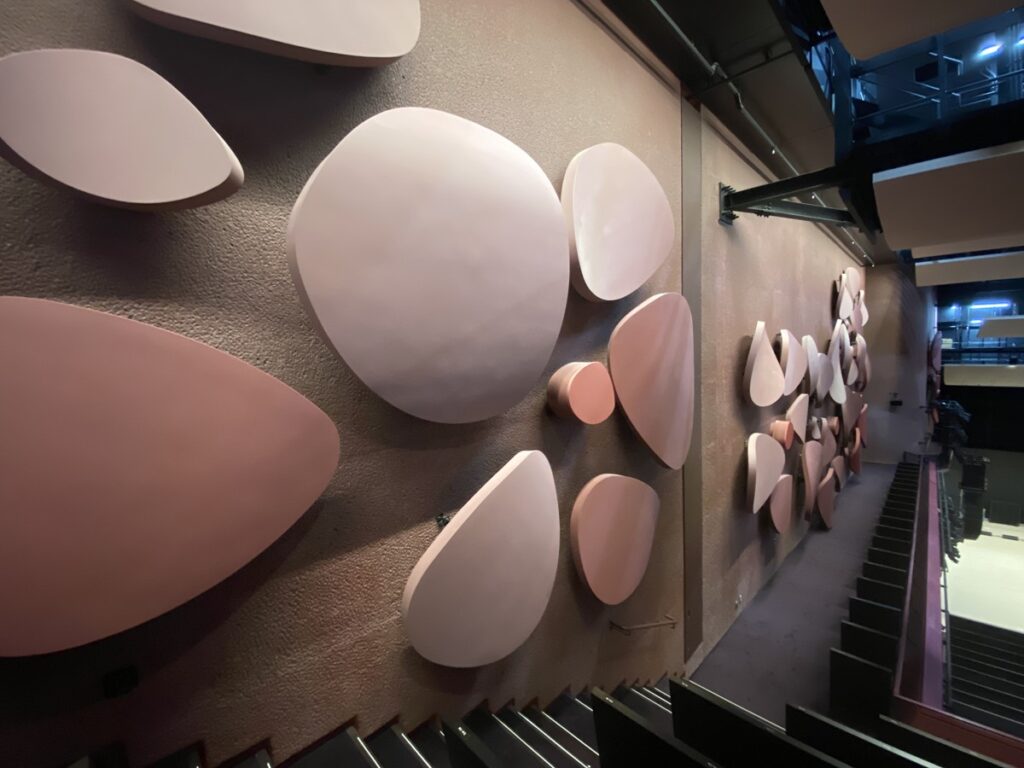
「早いのが取り柄」のこのBUNGA NETでなぜすぐに見に行かなかったのかというと、オープン直前の内覧会のときに筆者(宮沢)がスペイン出張中で行けず、その後も、大ホールを見られるタイミングがなかなかなかったからだ。だが、結果的には「伊東豊雄の挑戦 1971-1986」展を見るのと同じタイミングで見ることができて、納得感が増した。
(さらに…)